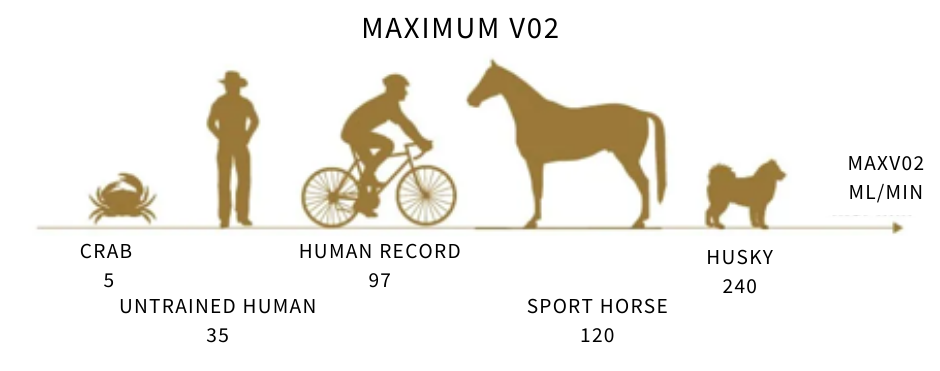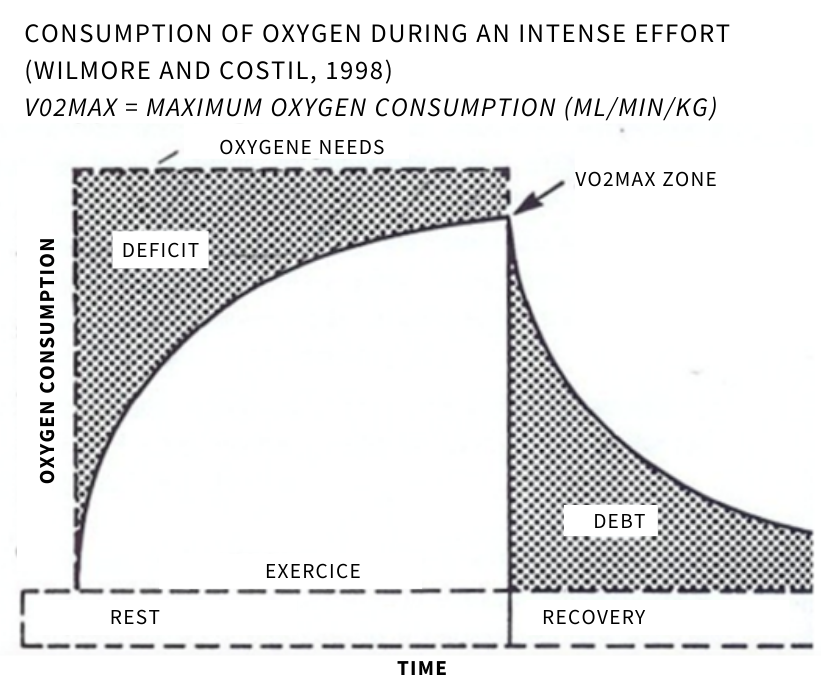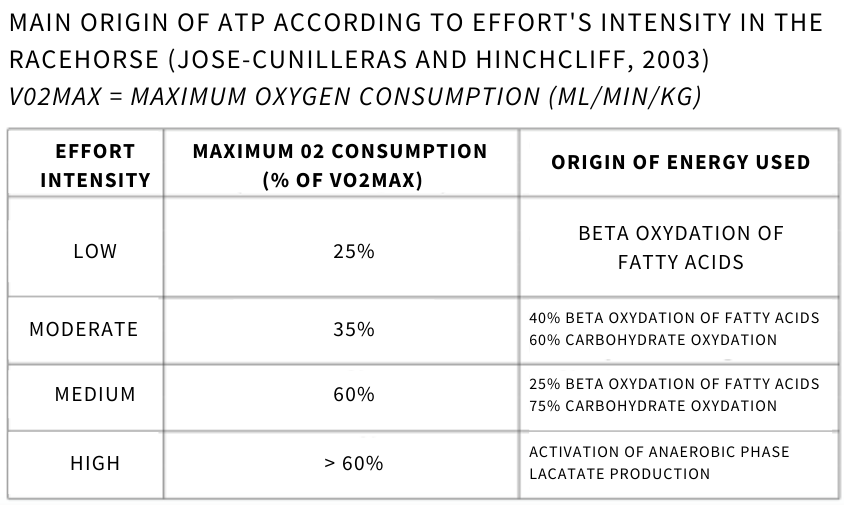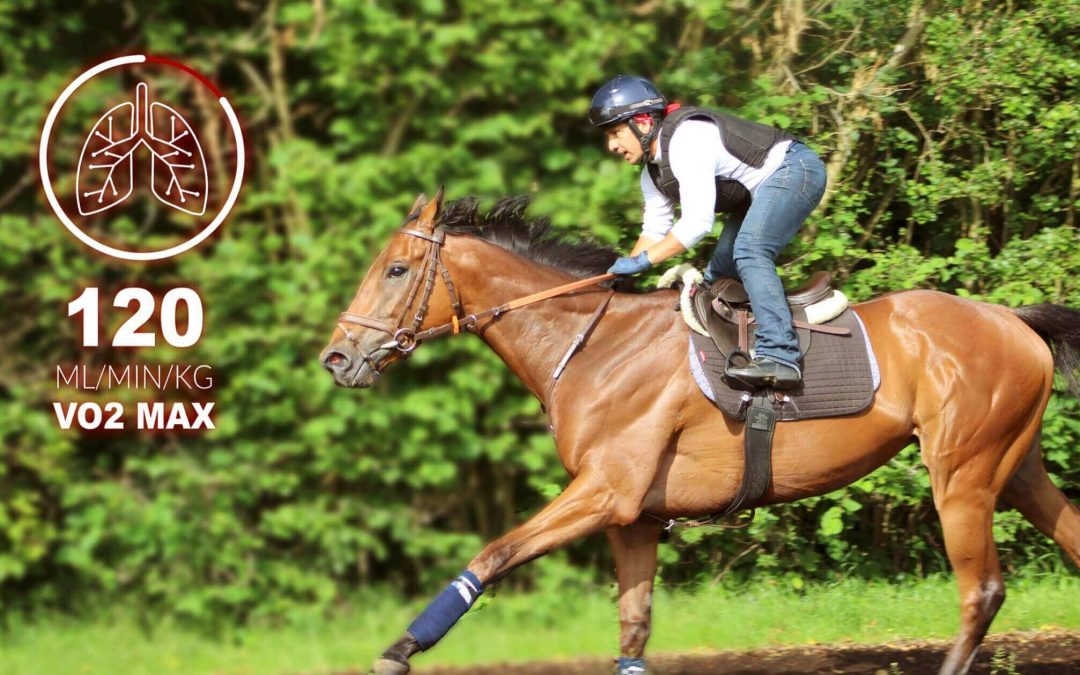Warning: number_format() expects parameter 1 to be float, string given in /var/www/wordpress/wp-includes/functions.php on line 425
VO2Max is one of the critical parameters for measuring the intensity of an athlete’s horse’s effort. There are two other complementary parameters: heart rate and lactatemia. These values are accurate indicators of training intensity and objectivize the body’s response to a given exercise. The following table shows the critical importance of these different indicators.
Recap of different indicators of effort’s intensity according to other authors.
VO2Max = maximum consumption of oxygen ; BPM = beats per minute
| INTENSITY | % OF VO2MAX | LACTATEMIA (mmol/l) | HEART RATE (bpm) |
| Low | < 55% | < 2 | < 100 |
| Moderate | 55% | 2 to 4 | 120 to 150 |
| Important | 80 to 100% | > 4 | > 150 |
| Author | Clayton, 2013 | Barrey, 1994 | Authie, 2011 |
Source: V. Moucheboeuf, 2018.
In this article, we will solely focus on VO2Max.
What is VO2Max in racehorses, and how is it measured?
VO2Max is the maximum volume of oxygen a horse can use. In short, it is the amount of oxygen consumed during exercise. This value is expressed in ml/min(/kg). A horse reaches its VO2Max at its maximum speed. It is important to know that the higher this figure is, the longest sustained physical effort. Thanks to the percentage of VO2Max (or maximum heart rate), it is possible to quantify the intensity of the effort. This value, as shown in the following graph, is different for different living beings.

The average VO2Max of a horse is therefore much higher than the maximum recorded in humans. It quantifies the organism oxygenation during an effort and is, up to today, one of the best indicators of the performance level. Moreover, the heart rate strongly correlates with the volume of oxygen consumed by the body. The aerobic threshold is at 60% of the VO2Max, and the anaerobic threshold is about 85% of the VO2Max. Thus, the more intense the effort, the greater the oxygen consumption.

Source: V. Moucheboeuf, 2018.
While the use of VO2Max in humans has become frequent and widespread, it is struggling to follow the same trajectory in the equestrian sector. The reason for this difference is purely practical. It is simple to perform an effort test on a human by breathing through a mask to measure the volume of air used. In contrast, performing this test on a horse is much more complicated and expensive.
How do you estimate the VO2Max of a horse?
Although the traditional measurement of VO2Max is difficult, many studies aim to estimate it. As VO2Max is a valuable indicator in the daily training of high-level athletes, it is essential to evaluate it at least. The submaximal test can predict V02Max. It indicates it by analyzing the cardiac and lactate data in the blood during an effort. Thanks to the ECG and lactate analyzer, these data are more easily retrievable in horses. Furthermore, during such a test, the horse does not reach its VO2Max, thus not endangering its health.
Why is the VO2Max used in racehorse training?
1. The most reliable indicator for assessing performance
Evans and R. Rose (1998) have shown that VO2Max is the most reliable indicator of maximum aerobic capacity. In a series of tests on the same horse, V02Max was the indicator with the best reproducibility rate, with coefficients of variation between 1.4 and 9.0%.
In short, to evaluate the maximum performance capacity of a racehorse, the VO2Max is the most precise and resourceful indicator.
2. A key indicator for race strategy
The study by Q. Mercier and A. Aftalion (2020) shows that in racing, the horse’s VO2Max is reached 20 to 30 seconds after the start, much faster than in humans. “The decrease in VO2 and the increase in speed at the end of the race coincide. The more the horse can maintain its VO2Max, the better its performance. The sprint start is optimal when the VO2 starts to decrease, especially in long races.”
The VO2Max is, therefore an indicator that can help when establishing race strategies. If horses work on this process d training, it can be decisive in the race.
3. An indicator for calculating training intensity
The V02Max makes it possible to calculate the intensity of an effort, thanks to training zones. Generally classified from 1 to 5, these zones classify effort according to their intensity. An effort in zone 5, the highest, will require 90% or more of a horse’s VO2Max.
During an easy effort (zone 1 to 2), the horse consumes oxygen equal to approximately 25% of its VO2Max. Conversely, during an exercise of “important” intensity, the oxygen consumption is higher than 60% of the VO2Max, creating an oxygen deficit in the horse. In general, soft gallop requires about 50% of VO2Max, whereas canter requires 90 to 100% of VO2Max and up to 115% during a sprint (F. Bermann, 2010).

Source: V. Moucheboeuf, 2018.
These training zones are crucial to optimize a horse’s training load (and avoid under or overtraining). In addition, they also allow trainers to target a horse’s training: anaerobic work in the higher zones and aerobic work in the lower zones. Finally, it will enable to individualize the training and the intensity. The goal is to tailor it to their respective capacities and potentials.
4. An indicator for longitudinal performance monitoring
VO2Max, unlike MaxHR, can change over time. It is highly dependent on the horse’s genetics and its age, sex, training level, and the time of the season.
This indicator can therefore be part of a longitudinal monitoring routine, quantifying the progression of a horse over time. The data will enable us to see the evolution and quantify the energetic cost of each effort required from the horse.
Conclusion
The training challenge is to increase the speed threshold at which VO2Max is reached, the anaerobic threshold. Thus, a trained horse will have a lower V02 for the same exercise than an undertrained horse and a higher VO2Max.
Trainers and vet teams cannot routinely measure VO2max in the athlete horse. Therefore, indirect measurements are preferred. Indeed, the heart rate during exercise will evolve in the same way as the V02. Thus, a trained horse will have a lower heart rate, as a percentage of its maximum heart rate, for the same exercise as an untrained horse.
Keywords: racehorse training, VO2Max, oxygen consumption, tailored training, effort intensity, anaerobic, aerobic, heart rate, racehorse training monitoring
Bibliography
Moucheboeuf, 2018. Caractérisation de la charge de travail du cheval de sport: étude expérimentale des liens entre paramètres physiologiques et biomécaniques.
D. Evans and R. Rose, 1998, Determination and repeatability of maximum oxygen uptake and other cardiorespiratory measurements in the exercising horse
Q.Mercier et A.Aftalion, 2020. Pacing strategy in horse racing.
P.Galloux, 2017. Evaluer la condition physique de son cheval pour individualiser son entraînement
F.Bermann, 2010. Les bases de la physiologie de l’effort

